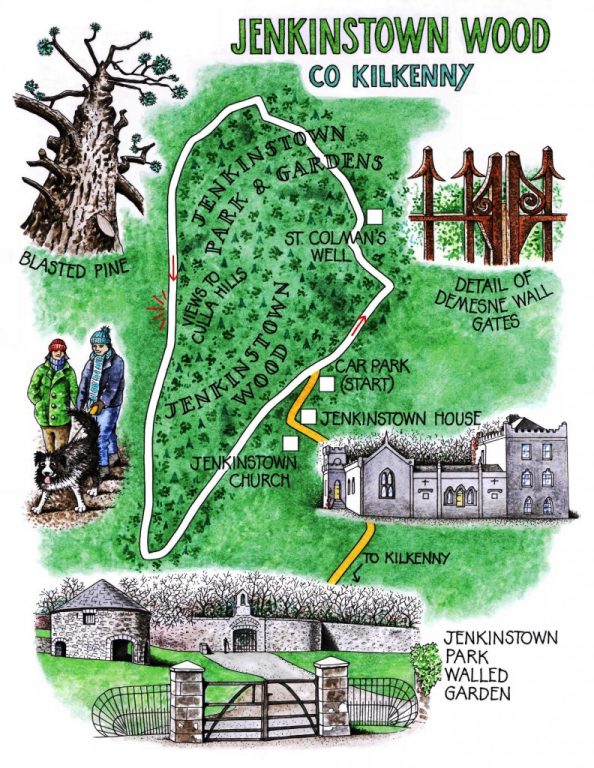 Irish Independent – WALK OF THE WEEK – Christopher Somerville
Irish Independent – WALK OF THE WEEK – Christopher Somerville
published 22 January 2011
Dappled afternoon light and a strong breeze over County Kilkenny, an hour or two to kill, and a definite itch in my feet, too long cramped together under the computer desk. Where to get a bit of a leg stretch before sundown? How about Jenkinstown Wood, a few miles north of Kilkenny town? Whip round that in an hour, and be back in time for tea …
It didn’t pan out like that. Jenkinstown Wood might be small, a few acres of trees caught inside an old parkland wall, but there’s more fascination here than you’d find in most places of comparable size. The remnants of a much larger Big House park, the wood is a fine mixture of dark spruce and pine with classic old estate trees – beeches like smooth-skinned giants, stripped to the buff in their winter leaflessness, and gnarled old oak and ash. At this time of year one’s footfalls ring on the ice-hardened ground and crunch through frosted leaf piles. In the depths of a hard winter, the time of birdsong and bluebell glades seemed so far in the future it might never come again.
On guard at the entrance to the park stood the creeper-hung conglomeration of Jenkinstown House with its purpose-built chapel wing. I peered over the wall at the house, so solid-seeming, yet with a shaky history. It was built in the 1820s for the young baronet Sir Patrick Bellew, owner of the Jenkinstown estate. The first attempt at the mansion, incorporating an earlier house, was so poorly designed that Bellew engaged architect Charles Anderson to draw up plans for a replacement. That version was so wobbly it actually fell down, causing Anderson to flee Ireland in disgrace and Bellew to commission the present house. So far, so good with that one …
‘La, la-la-la, dum, dum-dee-dum …’ I couldn’t help but have a little hum to myself as I stepped through the ‘hole in the wall’ and set off along the woodland trail.
‘’Tis the last rose of summer left blooming alone,
All her lovely companions are faded and gone …’
What a peach of a song, ‘The Last Rose Of Summer’, and poet Thomas Moore was staying here in Jenkinstown House (a forerunner of those ill-fated flophouses) when he composed the words in 1805. Everyone loved it – both Beethoven and Mendelssohn provided melodies to set it to, and soon ‘The Last Rose’ was required material round every self-respecting parlour piano. The poem might be massively dewy-eyed and emotional, not to say sentimental, but Moore himself was no swooning milksop. Shortly after penning ‘The Last Rose Of Summer’, the prickly-tempered bard took exception to a critical notice of one of his books in the Edinburgh Review, and challenged its editor Francis Jeffrey to a duel. But the two men kissed and made up as their seconds were actually loading the pistols.
Death and adversity have transfigured certain of the Jenkinstown trees. I passed a vast Scots pine as tall as a castle tower, its trunk fantastically fissured, its limbs blasted off by lightning, still defiantly sprouting punky tufts of dark foliage. Nearby a giant redwood had been felled, its trunk sawn off at man height and left for wind, rain and insects to sculpt. Children swung on the fallen branches, squealing with delight. Three under-4’s were hauling a bough along. ‘This tree’s falled down and we’re mending it!’
A side path led to St Colman’s Well, a stone box of limpid water among sprouts of hart’s-tongue and liverwort. Back on the main track I walked the western perimeter of the wood, following the grey ribbon of a demesne wall punctuated with ancient cast-iron gates. The views out between their curlicues and spear-heads showed the long backs of the Culla Hills way out west in a chilly sunset.
It came as a shock to find myself drawn out of the secret garden of Jenkinstown Wood and propelled in imagination into the outside world. I might have come up with a song to rival Thomas Moore, if only I’d remembered to pack my poetic mojo. Instead I caught a piece of thistledown as it shimmered past, and made a wish as I turned for home through the twilight. Did it come true? Well – I think it’s fair to say the jury’s still out on that one …
WAY TO GO
MAP: OS of Ireland 1:50,000 Discovery 60; downloadable map/instructions (highly recommended) at www.discoverireland.ie/walking.
TRAVEL:
Rail (www.irishrail.ie): Kilkenny (7½ miles)
Bus: Buggy’s Coaches (056-444-1264) from Kilkenny
Road: Follow brown ‘Jenkinstown Church and Gardens’ signs from N77/N78 just north of Kilkenny
WALK DIRECTIONS: From the map board in the main car park, bear right through a hole in the wall, then left along the forest path with the wall on your left. Follow this path, waymarked with purple arrows, all the way round the Park perimeter.
LENGTH: 1½ miles: allow 1 hour
GRADE: Easy
CONDITIONS: Level path underfoot all the way
DON’T MISS … !
• A peek over the wall at Jenkinstown House
• Tree sculptures near the hole in the wall
• Views to the Culla Hills through the old wall gates
REFRESHMENTS: Picnic
WALKING in IRELAND: Walking tour operators, local walks including Discover Ireland’s National Loop Walks, walking festivals throughout Ireland: www.discoverireland.ie/walking.
Glen of Aherlow Winter Walking Festival: 28-30 January (062-56331; aherlow.com)
INFORMATION:
Walks and activities: www.trailkilkenny.ie
Kilkenny Tourist Office: 056-775-1500; www.discoverireland.ie/southeast